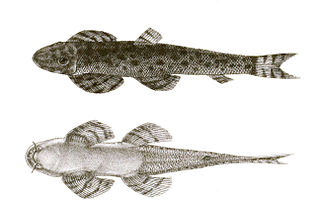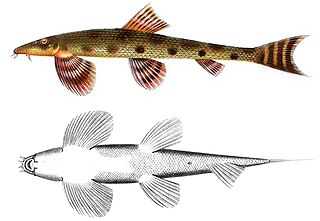
Balitoridae, the hillstream loaches or river loaches, is a family, of small fish from South, Southeast and East Asia. The family includes about 202 species. They are sometimes sold as "lizardfish" or "flossensaugers". Many of the species are popular for aquaria, species in the genus Sewellia are most commonly sold in the aquaria trade. They have a number of similarities with the Cobitidae, their sibling family of "loaches", such as multiple barbels around the mouth. They should not be confused with the loricariids, which look similar but are a family of catfish.

Hemimyzon is a genus of freshwater ray-finned fish belonging to the family Balitoridae, the river or hillstream loaches. The species in this genus are found in eastern Asia.

Balitora is a genus of ray-finned fishes in the family Balitoridae endemic to Asia.

Homaloptera is a genus of ray-finned fish in the family Balitoridae.

Balitoropsis ophiolepis, the slender lizard loach, is a species of freshwater ray-finned fish belonging to the family Balitoridae, species in this family are commonly called the hillstream loaches, although this common name also refers to the loaches in the family Gastromyzontidae. The slender lizard loch lives in rocky riffles in fast flowing hill streams in the basins of the Musi and Tulang Bawang Rivers in southern Sumatra and the Kapuas River in West Kalimantan on Borneo in Indonesia.

Balitoropsis zollingeri the black lizard loach, is a species of freshwater ray-finned fish belonging to the family Balitoridae, species in this family are commonly called the hillstream loaches, although this common name also refers to the loaches in the family Gastromyzontidae. The black lizard loach is found in unpolluted streams with a fast current, high levels of dissolved oxygen and rocky beds. It shows a preference for areas where there are pebbles, rocks, boulders or bedrock completely covered in algae.

Hypergastromyzon is a genus of ray-finned fish belonging to the family Gastromyzontidae, commonly called the hillstream loaches, although this also refers to the loaches in the family Balitoridae. The loaches in this genus are endemic to the island of Borneo in Southeast Asia.
Metahomaloptera is a genus of freshwater ray-finned fishes belonging to the family Balitoridae, the loaches in this family are commonly known as hillstream loaches although this name also refers to the loaches in the family Gastromyzontidae. These loaches are endemic to China.
Parhomaloptera is a monospecific genus of freshwater ray-finned fish belonging to the family Gastromyzontidae, a group which shares the common name hillstream loaches with the family Balitoridae. The only species in the genus is Parhomaloptera microstoma. It lives in fast-flowing streams and grows to a maximum published total length of 8.8 cm (3.5 in). This taxon is endemi to Borneo, occurring in both East Malaysia and Kalimantan.

Plesiomyzon is a monospecific genus of freshwater ray-finned fish belonging to the family Gastromyzontidae, a group which shares the common name hillstream loaches with the family Balitoridae. The only species in the genus is Plesiomyzon baotingensis, a loach that is endemic to the river systems of Hainan.
Protomyzon is a genus of ray-finned fish belonging to the family Gastromyzontidae, commonly called the hillstream loaches, although this also refers to the loaches in the family Balitoridae. The loaches in this genus are endemic to Borneo.

Pseudogastromyzon is a genus of ray-finned fish belonging to the family Gastromyzontidae, commonly called the hillstream loaches, although this also refers to the loaches in the family Balitoridae. The loaches in this genus are found in fast-flowing streams and rivers in China.

Serpenticobitis, popularly known as serpent loaches, is a small genus of loaches found in the Mekong River Basin in Southeast Asia. It is the only genus in the family Serpenticobitidae.

Balitoropsis also known as the lizard loaches is a genus of freshwater ray-finned fishes belonging to the family Balitoridae, the loaches in this family are commonly known as hillstream loaches although this name also refers to the loaches in the family Gastromyzontidae. These loaches are found in mainland Southeast Asia, Sumatra and Borneo.

Homalopteroides is a genus of freshwater ray-finned fishes belonging to the family Balitoridae, the loaches in this family are commonly known as hillstream loaches although this name also refers to the loaches in the family Gastromyzontidae. These loaches are found in Southeast Asia.

Homalopterula is a genus of freshwater ray-finned fishes belonging to the family Balitoridae, the loaches in this family are commonly known as hillstream loaches although this name also refers to the loaches in the family Gastromyzontidae. These loaches are found only in Sumatra in Indonesia.

Pseudohomaloptera is a genus of freshwater ray-finned fish belonging to the family Balitoridae, the river or hillstream loaches. The species in this genus are found in eastern Asia.
Bashimyzon is a genus of freshwater ray-finned fishes belonging to the family Gastromyzontidae, a family which shares the common name hillstream loaches with the Balitoridae. These loaches are found in the Guangxi Province of China.
Engkaria is a monospecific genus of ray-finned fish belonging to the family Gastromyzontidae, commonly called the hillstream loaches, although this also refers to the loaches in the family Balitoridae. The only species in the genus is Engkaria eubranchus, a species formerly classified in the genus Hypergastromyzon, which is endemic to the Lupar River basin in southern Sarawak in Malaysian Borneo.
Labigastromyzon is a genus of ray-finned fish belonging to the family Gastromyzontidae, commonly called the hillstream loaches, although this also refers to the loaches in the family Balitoridae. The loaches in the genus are found in China.












